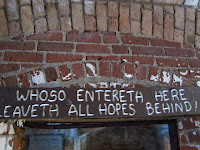Day Six (Thursday, March 15th):
I was really looking forward to the
desert island feel of camping overnight on the island but alas the generator for the park rangers ran all
night long. That sound wasn't too bad but the winds were a bigger concern. They picked back up in the middle of the night and I ended up having to take
off the rain fly at 3:00am as well as re-drive the stakes into the
ground and put bricks on top of them to anchor the Chateau.
 |
| The boats who spent the night moored at sea |
 The morning dawned somewhat cloudy which actually allowed me to get some good sunrise pictures.
The morning dawned somewhat cloudy which actually allowed me to get some good sunrise pictures.

We packed up our gear and had it down by the docks so it could be loaded back onto the ferry when it arrived. I waited by the beach to spy the ferry coming in. It was a welcome sight (food! cold water! indoor plumbing!)
We decided to take the fort tour to learn more about what we had explored yesterday. Ranger Chris was a great guide and I learned so much about the island and the fort.
 For instance, the name is so called because: Dry, because none of the islands has fresh water and Tortugas, because Ponce de León, a Spanish explorer, saw an abundance of sea turtles on the island. This lack of water presented a huge problem when the fort existed. An extensive rainwater collection system was built, but the islands only get scant rainfall.
For instance, the name is so called because: Dry, because none of the islands has fresh water and Tortugas, because Ponce de León, a Spanish explorer, saw an abundance of sea turtles on the island. This lack of water presented a huge problem when the fort existed. An extensive rainwater collection system was built, but the islands only get scant rainfall. Fort Jefferson is a massive but unfinished coastal fortress. It is the largest masonry structure in the Western Hemisphere and is composed of over 16 million bricks. The fort was never completed because of fears that additional bricks and
cannon would cause further settling and place more stress on the
structure and the cistern system. Distinguishing features include
decorative brickwork and 2,000 arches. The fort was constructed to protect shipping in the Gulf as the island afforded a safe anchorage at all seasons, and was there was a sufficient depth of water for ships. During its peak there were more than 2,000 people at the Fort but never a hostile shot was fired. During the Civil War the Fort was used as a prison for Union deserters and its most famous prisoner is Dr. Samuel Mudd who was convicted of conspiracy in the assassination of President Abraham Lincoln because he set his leg after Booth injured it jumping from the balcony.
Fort Jefferson is a massive but unfinished coastal fortress. It is the largest masonry structure in the Western Hemisphere and is composed of over 16 million bricks. The fort was never completed because of fears that additional bricks and
cannon would cause further settling and place more stress on the
structure and the cistern system. Distinguishing features include
decorative brickwork and 2,000 arches. The fort was constructed to protect shipping in the Gulf as the island afforded a safe anchorage at all seasons, and was there was a sufficient depth of water for ships. During its peak there were more than 2,000 people at the Fort but never a hostile shot was fired. During the Civil War the Fort was used as a prison for Union deserters and its most famous prisoner is Dr. Samuel Mudd who was convicted of conspiracy in the assassination of President Abraham Lincoln because he set his leg after Booth injured it jumping from the balcony.The conditions were deplorable with scurvy (SCURVY!!) running rampant and morale always at a low. However, Ranger Chris pointed out that, compared to actually fighting in a war with bullets, maybe it wasn't all that bad.
I have been to many a fort and this is definitely one of my favorites. Dry Tortugas is one of the least visited National Parks but it played such an integral role in the history of our country that it is one of the most important ones.





No comments:
Post a Comment